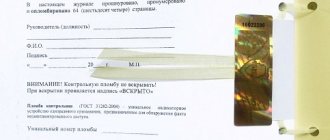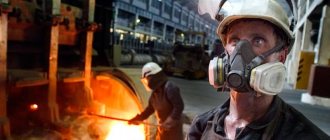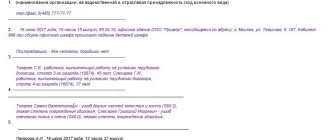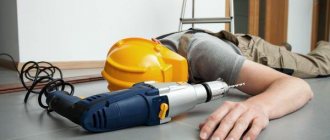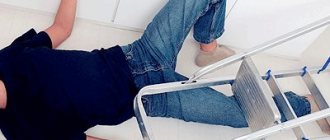What is meant by an accident at work?
An industrial accident is an unpleasant event that happened to a person during the performance of his work duties, leading to deterioration of health and entailing consequences provided for by law.
The consequences of such an incident can be: transfer to another job, complete loss of ability to work or professional skills, as well as death.
Injury during non-working hours
It would seem clear: injuries received during non-working hours are not related to production. But not everything is so simple, because an employee can act in the interests of the employer at any time.
Example No. 1
At the end of the working day, the employee went to dinner with business partners, where he planned to discuss the upcoming deal. The employer provided money for the meeting. During dinner, a fire started in the restaurant. The worker suffered carbon monoxide poisoning and was taken to the hospital. The incident was ruled an industrial accident because the employee was in the restaurant on behalf of the employer.
Regarding accidents during corporate events
, then they cannot be classified as production.
Example No. 2
During a corporate New Year's celebration, employees decided to set off fireworks. The fireworks were not secured securely, and one of the volleys hit the crowd. Several workers suffered burns. The accident was not related to production, because it did not occur during working hours and not while the employees were performing their job duties.
Types of accidents
Before considering the classifications of industrial accidents, it is necessary to understand their types:
- Industrial incidents. Cases that occurred with workers, pupils, students performing work on the territory of the enterprise on the instructions of the manager. This also applies to those who travel to or from the place of work using company transport, when performing work on holidays and weekends by order of management. Also as a result of poisoning, heat stroke, frostbite that occurred at work.
- Work-related misfortunes. Incidents that occurred while performing public or government duties, going to work on your personal or public transport, while participating in training and competitions, loss of ability to work in connection with blood donation functions, during business trips.
- Household. This category includes incidents that occurred off-site, outside of work hours, and not while commuting to or from work.
What accidents are considered non-work related?
Accidents involving workers come in different forms. But not every one of them can be associated with production: be it a minor injury or a serious injury. How to avoid making a mistake in classifying an accident and filing it correctly? Let's figure it out.
The employer must investigate and account for accidents
, if they:
- happened to employees during the performance of work duties or other instructions of the employer (part one of Article 227 of the Labor Code of the Russian Federation);
- led to the need to transfer the employee to another job, to the employee’s loss of ability to work or to his death (part three of Article 227 of the Labor Code of the Russian Federation).
Not related to production
The following accidents are considered to be:
- death of an employee due to a general illness or as a result of suicide confirmed by a medical institution and investigative authorities;
- death or health damage that an employee received while under the influence of alcohol, drugs or other toxic substances (unless this is associated with a violation of the technological process in which industrial alcohols, aromatic, narcotic or toxic substances are used);
- incidents that occurred with the employee during his illegal actions (for example, the employee was injured when, on the instructions of the employer, he was digging up a copper electrical cable on the territory of someone else’s organization).
Accident severity levels
It is impossible to determine the severity of the accident without conducting a certain investigation.
During it, an analysis of the circumstances of the incident is carried out, but the main aspect is the analysis of the factors that provoked the accident. Classification of the causes of an incident at an enterprise is a necessary basis for determining further investigation. There are several nuances to the organizational plan that triggered the incident that caused injury in the workplace, including:
- improper organization of work;
- uncontrollability of the labor process;
- disorder in the workplace;
- poor quality worker training;
- failure to provide safety training in a timely manner;
- lack of special clothing and protective equipment;
- untimely repair of equipment;
- violation of labor discipline.
Each of the above reasons can become a catalyst that provokes an accident.
Incident Prevention
While employees perform any job duties, they are exposed to certain risks. Therefore, the employer is obliged to take preventive measures to avoid such situations. Among the mandatory effective measures are the following:
- Induction training . It is carried out with all newly hired employees, as well as people undergoing internship. It is mandatory to introduce basic safety rules, the procedures of the enterprise, as well as the rules for providing medical care.
- Initial briefing . It is carried out directly at the workplace before the employee begins to perform his duties.
- Re-instruction . It is carried out periodically to test the employee’s knowledge of the safety rules that he received during the first briefing.
- Unscheduled . Such information should be provided to the employee when changing the technological process, installing new equipment and for other similar reasons.
- Current briefing . It is carried out in cases where it has been revealed that an employee is violating safety rules.
The employer is also obliged to provide employees with all the necessary knowledge and skills to perform their duties without causing harm to their health. He is obliged to send them for training and advanced training, as well as conduct appropriate certification of their knowledge.
Actions of a manager in case of injury at the enterprise
If an accident occurs, the classification of which is presented above, the employer must:
- Provide first aid to the victims, if necessary, take them to a medical facility.
- Do everything possible to prevent an accident and prevent injury to other workers.
- Record the situation, take photos or videos.
- Report the incident to special authorities within 24 hours.
What is not considered a work injury?
Not every injury is work-related. In some cases, even if an employee was injured directly at work, the injury cannot be blamed on the employer. What does not apply to production? injury:
- self-harm, suicide - if this is confirmed by the investigation;
- injuries that were accompanied by alcohol or drug intoxication;
- domestic injuries not related to the production process, regardless of the time and place of occurrence;
- damage that occurred during a corporate party or other group celebrations;
- injuries received during or after the commission of a crime.
Please note that physical harm caused to an employee by other people can be classified in two ways. Here the investigation will study all the circumstances.
What should an employer do?
Any event that occurs at work should not go unnoticed by the employer. First, the manager provides first aid to the victim, and then investigates the circumstances and causes of the incident. The “productivity” of the injury is determined by the consequence. Please note that any work-related injury entails legal liability for the organization.
Standards
The safety of employees in the workplace is the responsibility of the employer. Failure to fulfill such duties may result in administrative liability. After providing the injured party with the necessary medical care, it is necessary to find out whether the incident can be considered a work-related injury.
- It is necessary to call an ambulance and send the injured person to a medical facility.
- The employer is obliged to immediately prevent a reoccurrence of the incident if the cause is obvious and remediable (for example, if an employee receives an electric shock, it is necessary to de-energize the territory of the enterprise).
- The scene of the incident must be left untouched until specialists arrive to investigate the incident.
- It is necessary to assemble a commission, which includes: a labor protection specialist, a representative of the employer, a representative of a trade union or similar organization. It is also necessary to attract witnesses to what happened.
- Send a commission to the scene of the incident.
The employer is responsible for the safety of not only employees, but also trainees, delegates of other organizations, convicts and patients of the medical treatment facility involved in work.
In addition, the injured party is legally authorized to serve on the commission investigating the incident.
The commission is obliged:
- Inspect the scene of the incident;
- Interview the injured party;
- Conduct interviews with witnesses and eyewitnesses;
- Study the medical report.
All surveys must be recorded in separate protocols, and after studying the documents, an act must be drawn up according to the approved form N-1.
Time frame for investigation
The timing of the investigation directly depends on the complexity of the incident. Three days from the moment of the incident are allocated for a standard investigation. However, the investigation period will be increased to fifteen days in two cases:
- The victim died;
- A group of people were injured.
Within 24 hours from the moment of death of an employee and/or injury to a group of employees, the employer must notify its industry department, the territorial department of the State Labor Inspectorate, the prosecutor's office and the department of the Social Insurance Fund.
Required documents
Upon completion of the investigation, if the injuries received are recognized as a work-related injury, the organization must ensure that the employee receives compensation and/or benefits. To do this, the following documents or copies are sent to the FSS: notification, investigation order, act N-1, protocols (interviewing witnesses, responsible officials, site inspection), medical report, employment contract or book, SNILS, certificate in form 316/u and reporting the consequences of NS.
You can always check the current list of documents on the FSS website. This list is often individual and depends on the severity of the injuries and the complexity of treatment.
Injury rate at the enterprise
To classify and record an industrial accident, the injury rate must be applied:
- Frequency factor. Allows you to determine the number of injuries over a certain period of time at a specific enterprise, expressed as a percentage.
- Gravity coefficient. Determines the relationship between the number of days of incapacity for work and the number of work-related injuries.
- Disability rate. Determines the value obtained by multiplying the frequency coefficient by the gravity coefficient. This indicator allows you to qualitatively assess the consequences of an emergency at work.
General classification of all NS
Before proceeding with the investigation, it is necessary to make sure that the injury is directly related to the production process, and when contacting a medical institution, the patient reported this, and the doctor entered code “04” on the sick leave sheet - industrial injury.
All NS can be divided into industrial and household (those that do not fall under the definition of industrial).
Features of accident investigation
During the investigation of an accident, a labor safety inspector must be involved.
If the incident occurred as a result of an accident, then the investigation must be accompanied by materials collected by a representative of the traffic police. Also, a commission, which is specially created to classify an accident and identify those responsible, must conduct a survey:
- the victim, if possible, in other cases a special act is created;
- eyewitnesses of the accident;
- persons who allowed the emergency to occur;
- persons who committed safety violations;
- the manager of the enterprise where the incident occurred.
The victim must explain in writing why the accident occurred. If he cannot write independently or he refuses to give any explanations, then a special act is drawn up, which will make it possible to determine that all actions concerning the victim were carried out correctly and in compliance with all norms and standards.
Investigation
This event is always carried out by special commissions, which are formed differently depending on the number of victims and the circumstances. The number of commission members must be odd and it must include the following persons:
- directly the employer himself or his representative;
- specialist related to labor protection;
- trade union members.
The appointment is made on the basis of an order. The victim himself, as well as his immediate supervisor, are not involved in the investigation. However, they have the right to receive information about the investigation. If the information was not submitted for investigation in a timely manner, the circumstances of the incident may be investigated within a month after the victim himself filed an application. In this case, the statute of limitations for such an incident will not be taken into account.
If the incident occurred with several employees at the same time, then the investigation is carried out within 15 days. For this purpose, an order on the appointment of a commission must also be drawn up. The employer is obliged to involve all the necessary specialists, as well as provide all the necessary means to conduct the investigation.
The commission must do the following:
- Establish the reasons based on all the prevailing circumstances.
- Determine whether this case is considered industrial.
- Identify those responsible for these violations.
- Determine the measures necessary to prevent further similar incidents.
- Will draw up a report of the investigation.
If during these activities a gross violation committed by the employee himself is revealed, then the degree of his guilt must be determined. There can be 2 main types of it: intentional or due to negligence.
Documentation for conducting an accident investigation
In order to correctly classify and investigate an accident, it is necessary to prepare a package of documents:
- an order to create the appropriate commission with a list of all its representatives;
- diagram of the scene of the incident;
- photo and video materials;
- accident scene inspection report;
- workplace certification card;
- explanatory statements of victims or drawn up acts;
- technical calculations and research protocols;
- conclusion of the experts who assessed the accident;
- medical report on the condition of the victim;
- card for issuing protective equipment and protective clothing;
- extracts from the safety magazine.
Members of the commission may request additional documents if the standard package of documents did not allow them to conduct a high-quality study and render a verdict.
The persons who must be held accountable for the accident must be identified. Classification by severity makes it possible to determine whether the victim will be able to continue working in the future or whether he needs to be assigned recourse - unemployment benefits resulting from an industrial accident.
Classification of accidents from the point of view of investigation
IMPORTANT! Recommendations for conducting an investigation of an industrial accident from ConsultantPlus are available here
Each accident must be investigated, which is documented in accordance with the law. The degree of harm caused to the victim’s health must be indicated. Since this document will have force and further legal consequences, the severity of the case cannot be indicated arbitrarily. There is a medical examination for this. The legislative basis is the already mentioned order of the Ministry of Health of the Russian Federation No. 160.
He does not consider the possible causes of a work injury, paying attention only to two characteristics of the incident:
- to what extent the employee’s health was damaged and whether the damage affected the course of existing chronic diseases;
- how long this damage will persist over time, that is, whether the consequences for work ability will be permanent or irreversible.
IMPORTANT! Any of these signs, even in the singular, is qualifying for establishing the degree of severity.
According to this principle, all consequences of industrial injuries are divided into mild and severe.
Not heavy means light
The leading principle in this division is the principle of exclusion. The order regulates severe NS, all others are automatically classified as mild. Let's consider what the Ministry of Health means by the serious consequences of industrial injuries.
A severe degree of health damage due to work-related illness implies a sharp disruption of the normal state, which causes loss of ability to work for more than 1 month, possibly with lifelong consequences (disability).
FOR YOUR INFORMATION! The first sign of the undoubted severity of the case is a threat to the employee’s life due to damage to health. If, due to his injuries, he theoretically could have died, then the case will definitely be considered serious, even if help was provided on time and the person remained alive.
A special table in this Order describes the possible severe consequences of an industrial accident.
3 degrees of damage severity
Severe consequences are divided into 3 stages in descending order of the danger of bodily injury and the irreversibility of their consequences:
- Damage that was initially caused by shock, hemorrhage (blood loss), problems with vital organs (liver, kidneys, lungs, heart, cardiovascular and central nervous system). NS is considered severe, even if a person recovers fairly quickly from such injuries.
- Delayed consequences - do not appear immediately, but are identified by an ambulance doctor, emergency room, intensive care unit, etc. Examples include skull fractures and wounds, spinal injuries, organ ruptures, miscarriage during pregnancy, burns affecting more than 15% of the body, and other severe injuries.
- Severe consequences, irreversible, but not life-threatening, for example:
- blindness (in 1 or both eyes);
- numbness and/or deafness;
- loss or cessation of functioning of any organ;
- disfigurement (facial trauma);
- mental disorders.
A special case
Sometimes the injury itself is not so serious that it may be considered severe. But it becomes a catalyst for processes that cannot be stopped, and they can lead to death. In such a situation, NS is also considered severe.
An example is the unfortunate case of singer Anna German, who was in a car accident. Having received many fractures, she suffered for 15 years from severe pain, thrombophlebitis and ultimately died from sarcoma - cancer in the bones. A forensic examination proved that all these problems occurred as a result of the injury.
Can an employer finance preventative measures to reduce accident insurance premiums ?
Measures to prevent accidents
Every production facility, even if it only employs a few people, must have a qualified specialist who monitors safety precautions. He must regularly instruct not only newly hired workers, but also those who have already been working for him for a long time. The occupational safety instructor keeps a log where each employee puts his signature confirming that he is familiar with safety precautions. This log may be requested by a commission representative if an accident occurs. The types and classification of incidents will help identify the culprit and prevent future injuries.
It is easier to prevent an accident than to eliminate its consequences. Therefore, prevention methods are important. If a labor safety inspector notices that an employee is violating safety precautions, for example, not wearing protective equipment, then he may not only be suspended from work, but also financially punished.
Safety instructions are regularly updated every 5 years, but can be more often if new equipment suddenly appears in production.
Training can be carried out at any time, especially if the safety officer has detected violations. It is also carried out if an employee returns from vacation or changes the subject of work.
A good way to prevent accidents at work are stands and corners on occupational safety, where all incidents are described and measures to help prevent their occurrence are indicated. Posters, pictures, and constant reminders will make the worker think about whether it is worth violating safety standards.
Compliance with all safety rules will help preserve not only the health of the employee, but also his life. The head of the enterprise and the labor safety inspector bear criminal liability if a worker is injured in their production, even if it is minor.
Measures to prevent NS
To reduce the number of injuries and deaths at work, management applies the following measures:
- selects suitable premises and high-quality certified equipment for work;
- competently selects workers, registers them and trains them on how to work correctly to avoid injury;
- provides workers with special uniforms and means to ensure personal protection;
- Conducts timely assessments to adjust working conditions;
- provides employees with established social benefits for recreation, and deals with their mandatory insurance for work in the workshop;
Measures to eliminate NS
- forces employees to undergo medical examinations in a timely manner;
- explains to employees how they should act at the enterprise and clearly demonstrates the consequences of failure to comply with occupational safety rules;
- controls the occupational safety knowledge acquired by employees and checks the procedure for fulfilling established requirements;
- conducts professional instruction in a timely manner and records the lesson in the documentation;
- prepares safe work rules and sample documents for them.
Note! Thanks to the correct and careful selection of personnel, it is possible to minimize the occurrence of emergency incidents, since accidents happen less often with qualified employees.
In general, an accident in a factory is a situation where a person was injured during work and this fact was recorded by a special medical commission. Accidents are divided into types. There are NS of the first, second and third degrees of severity. To reduce their number, preventive work is carried out at enterprises.
Types of severe NS
Order No. 106 describes only severe accidents according to the severity of health damage. Therefore, mild cases are determined by the principle of exclusion: what is not severe is mild.
The table below provides a complete list of serious accidents.
| List of serious accidents | ||
| № | Diagnosis | What does it include |
| 1 | Health damage with an acute period of occurrence | May be accompanied by: • shock; • coma; • blood loss (volume – from 20%); • embolism; • acute failure of the functions of vital organs and systems (central nervous system, cardiac, vascular, respiratory, renal, hepatic and (or) a combination thereof). |
| 2 | Health injuries identified during the initial examination of the victim: • by hospital doctors; • trauma center; • or other honey. organizations. | The list is as follows: • penetrating wounds of the skull; • fracture of the skull and facial bones; • brain contusion; • intracranial injury; • injuries penetrating the lumen of the pharynx, trachea, esophagus, as well as damage to the thyroid and thymus glands; • penetrating injuries of the spine; • fracture-dislocations and fractures of the bodies or bilateral fractures of the arches of the I and II cervical vertebrae, including without dysfunction of the spinal cord; • dislocations (including subluxations) of the cervical vertebrae; • closed injuries of the cervical spinal cord; • fracture or fracture-dislocation of one or more thoracic or lumbar vertebrae, including without dysfunction of the spinal cord; • chest injuries penetrating the pleural cavity, pericardial cavity or mediastinal tissue, including without damage to internal organs; • abdominal wounds penetrating into the peritoneal cavity; • wounds penetrating the bladder cavity or intestines; • open wounds of the retroperitoneal organs (kidneys, adrenal glands, pancreas); • rupture of an internal organ of the thoracic or abdominal or pelvic cavity, retroperitoneal space, rupture of the diaphragm, rupture of the prostate gland, rupture of the ureter, rupture of the membranous part of the urethra; • bilateral fractures of the posterior semi-ring of the pelvis with rupture of the iliosacral joint and disruption of the continuity of the pelvic ring or double fractures of the pelvic ring in the anterior and posterior parts with disruption of its continuity; • open fractures of long tubular bones – humerus, femur and tibia, open injuries of the hip and knee joints; • damage to the main blood vessel: aorta, carotid (common, internal, external), subclavian, brachial, femoral, popliteal arteries or accompanying veins, nerves • radiation injuries of moderate (from 12 Gy) severity and higher; • abortion. Thermal (chemical) burns are specified separately: • III – IV degree with an affected area of 15% of the body surface; • III degree with a lesion area of 20% of the body surface; • II degree with a lesion area of 30% of the body surface; • respiratory tract, face and scalp. |
| 3 | Damage that does not directly threaten the life of the victim, but has serious consequences | These are: • loss of vision, hearing, speech; • loss of any organ or complete loss of its function by an organ (in this case, the loss of the most functionally important part of a limb (hand or foot) is equated to the loss of an arm or leg); • mental disorders; • loss of reproductive function and ability to bear children; • permanent facial disfigurement. |



